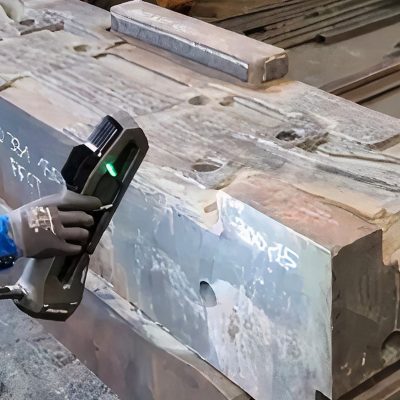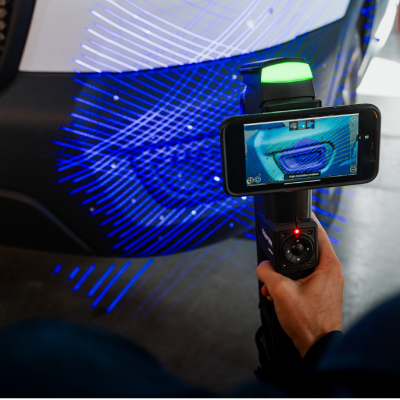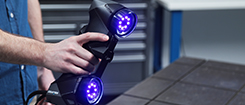April 15, 2024
Use of 3D scanner increases efficiency and reduces labor and material costs See the articleAccording to engineer Dr. Mostafa Abdel-Bary Ebrahim “a 3D scanner collects distance information about surfaces within its field of view. The “picture” produced by a 3D scanner describes the distance to a surface at each point in the picture. This allows the three dimensional position of the each point in the picture to be identified ”.
A short-range 3D scanner is usually defined as one that performs best within one meter of the object to be scanned. While there are many different technologies that can provide the 3D model of an object, these are usually divided into the broad Contact and Non-contact categories. For instance, coordinate measuring machines (CMM) are part of the available contact 3D scanning technologies, where the object is laid out and fixed on a specific plate, then probed through physical touch. This method is very precise, however, its main drawback is rigidity.
Non-contact technologies project light or radiation to assess the surface of an object. Among these, the most commonly used are triangulation and white light.
Triangulation
The triangulation technology also emits laser light to determine the shape and position of an object, but it uses a camera to locate the laser line or crosshair it projects. It is named that way because while the 3D scanner is in use, the laser emitter, the camera, and the laser line or crosshair form a triangle. Principles of geometry are applied to provide the 3D representation of the object: the length of one side of the triangle is known (the distance between the camera and the laser emitter), and so is the angle of the laser emitter. The third element needed to calculate the exact dimension of the triangle, the angle of the camera, can be resolved by figuring out the position of the laser projection from the camera.
We can distinguish two main types of scanners using triangulation: optical profilometers, which are fitted on a measuring arm, and portable 3D scanners.
Portable 3D scanners require reflective sensors to be placed either on or around the part to be digitized, which will be used as a positioning reference. As such, the sensors help the scanners achieve dynamic referencing, which means that measuring operations are directly performed in reference to the object. As a result, the device, as well as the object scanned, can be moved without impacting the accuracy. Optical profilometers use their arm or CMM (coordinate measuring machine) as a positioning reference, instead.
The range offered by triangulation-based 3D scanners is more limited, but the technology more than makes up for in accuracy: for this kind of technology, the precision is usually measured in tens of micrometers. As a comparison point, a human hair is about 100 micrometers thick.
White Light
This 3D scanner also uses triangulation and a camera system, but instead of a laser, it projects either a fringe light pattern, or a coded light pattern. The shape of the object is then decoded by calculating the returned patterns of light.
White light scanners can capture a whole area simultaneously, instead of a single line or crosshair at a time. This provides a great richness in details, and all but eliminates motion distortion. Some of these 3D scanners are even able to provide the live measurements of a moving object.
Scanners that projects a fringe pattern (sometimes called “structured light”) take their measurements over time. They require several sequential projections to be done at a given time, and their decoding occurs through a temporal projection. Their results are therefore not instantaneous, and require the device to be fixed, and still.
In comparison, white light scanners that project a coded pattern can be handheld and moved, which greatly increases their flexibility and ease of use. They provide very quick results, since their measuring area is larger, and the scanner decodes the specific light pattern for each frame the camera captures.
While still very reliable, white light coded light pattern scanners typically do not achieve the accuracy of triangulation 3D scanners, but they provide both unrivalled speed and flexibility. Further up the accuracy scale, we would then find the profilometer 3D scanner, followed by the white light fringe pattern.
Time-of-flight
As a counterpoint to these short-range technologies, we can also briefly discuss this other technology mostly used for long-range applications.
A time-of-flight 3D scanner uses a laser range finder to assess the surface of an object, based on the speed of light. It sends multiple pulses of light, and then calculates the time these pulses take to reach the object and come back.
A laser range finder can only measure a single point at a time within a given view direction, thus, it needs to constantly change its direction to scan. This is usually done through rotating mirrors, which can move extremely fast. Time-of-flight 3D scanners can normally measure between 10,00 and 100,000 points per second. Because they can have a longer range, time-of-flight scanners are especially suited for scanning large structures or areas. However, they tend to lack precision –unlike their short-range counterparts, their accuracy is typically measured in millimeters. These 3D scanners can also provide models that contain more noise around the edges of the object, due to the fact that in these areas, the light pulse returns from two different locations.
Conclusion
The available non-contact 3D scanning technologies each have their own specific preferred means of use and benefits, as well as their downsides.
Creaform, with its triangulation-based portable HandySCAN 3D and its LED coded white light Go!SCAN 3D, can truly bring out the best of all technologies. These scanners combine the principles of TRUaccuracy, which guarantees results no matter the environment or operator skills, TRUportability, which offers both ergonomy and freedom of movement, and TRUsimplicity, which provides ease-of-use as well as the possibility to scan virtually any surface.









1 Mar '18
Mills Jack
Nice OVERVIEW. SO helping for newbies.